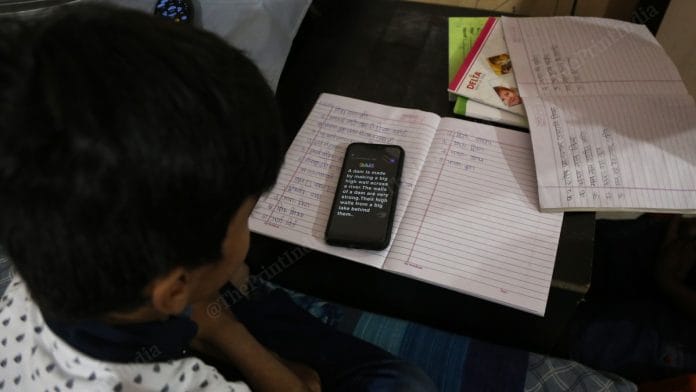New Delhi: A survey on learning gaps conducted after schools across the country remained closed due to the pandemic states that only eight per cent children in rural households attended regular online classes.
The survey called School Children’s Online and Offline Learning (SCHOOL) was conducted in August and was coordinated by economists Jean Drèze, Reetika Khera, Nirali Bakhla and Vipul Paikra with the help of a team of volunteers across states.
The team conducted the survey on 1,400 school children in underprivileged households across 15 states and UTs — Assam, Bihar, Chandigarh, Delhi, Gujarat, Haryana, Jharkhand, Karnataka, Madhya Pradesh, Maharashtra, Odisha, Punjab, Tamil Nadu, Uttar Pradesh and West Bengal.
Their findings show that “in rural areas, only 8 percent of sample children are studying online regularly, 37 percent are not studying at all, and about half are unable to read more than a few words.”
According to the survey findings, “most parents want schools to reopen as soon as possible.”
“The survey focused on relatively deprived hamlets and bastis, where children generally attend government schools. In each of the 1362 sample household, we interviewed one child enrolled at the primary or upper-primary level,” the report added.
Literacy rate
The report said an “absolutely dismal” picture emerged from the survey.
It found major discrepancies in the learning levels of children as they did not attend school for a prolonged period. Nearly 42 percent of children in classes 3-5 from rural household were unable to read a single word.
Children in Grade 2 — 65 percent in urban areas and 77 percent in rural areas could not read more than a few letters. “Remember, most of these children have never been to school (they were enrolled in Grade 1 last year, during the lockout). Soon they will be in Grade 3.”
“Even at the upper-primary level (Grades 6-8), the proportion of children who are able to
read fluently is just over half, in both rural and urban areas,” the report said.
The report also compared literacy rates of school children with average literacy rate of the same age group from the 2011 population census.
“At that time, according to the census, average literacy rates in the age group of 10-14
years ranged from 88 percent to 98 percent in all the school states except Bihar (83 percent); the all-India average was 91 percent,” the report said.
“Among school children, however, literacy rates in the 10-14 age group are as low as 75 percent in urban areas, 67 percent in rural areas, and 61 percent for rural Dalits and Adivasis,” it added.
“An overwhelming majority of parents felt that their child’s reading and writing abilities had declined during the lockout,” the report added.
Also read: Ensure all teachers are vaccinated with at least one dose by Sept, Modi govt tells states, UTs
Reopening of schools
The survey also said that most of the parents supported school reopening. “In urban areas, about 10 percent had some hesitation about this or even opposed the reopening of schools. In rural areas, however, 97 percent of parents supported reopening of schools,” the report said.
The report added that as schools reopen, children are all set to find themselves “thrice removed” from their grade’s curriculum. It said that this is due to “pre-lockout gap, decline of literacy and related abilities during the lockout and onward March of curriculum in that period”.
It cautions that dealing with this kind of gap will require “major changes in curriculum and pedagogy over an extended transition period” and can take years.
“The SCHOOL survey gives an inkling of the colossal damage created by this extended lockout – one of the longest in the world. As we saw, the damage is not lost on parents themselves,” the report said.
“It will take years of patient work to repair this damage. Reopening schools is just the first step, still being debated. In fact, even preparations for that first step (such as repairing school buildings, issuing safety guidelines, training teachers, enrolment drives) are virtually invisible in many states. After that, the schooling system needs to go through an extended transition period not only to enable children to catch up with a reasonable curriculum but also to restore their psychological, social and nutritional wellbeing,” it added.
The report concluded by saying that things heading towards “business as usual” is a “recipe for disaster”.
Also read: With 131 new institutions in 4 years, it’s boom time for private universities in India






